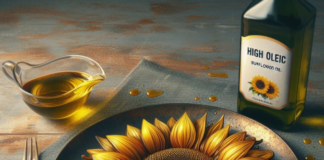Carmine
Do you know those bright red lollipops, candies, ice creams, and baked goods? Chances are they’re made with carmine, typical red food, and cosmetic dye.
Unlike other natural food dyes, like annatto — which comes from the achiote tree’s seeds, carmine is made with crushed insects.
That’s right — insects that are dried, ground and used to make a colorant.
On the other hand, this red colorant is not made from synthetic, potentially dangerous ingredients like coal or petroleum (like Red dye 40), so could it be considered the healthiest option?
Carmine does come with potential side effects, and it is, after all, made with insects, so it may be best to avoid it altogether.
What Is Carmine?
It is a dye that’s found in some food products to create a red color. The food colorant is also called cochineal extract, which comes from the insect species Dactylopius coccus Costa.
These cochineal bugs used to harvest carmine are mainly collected in Peru and the Canary Islands, where the insects live on prickly pear cacti.
Carmine’s uses date back to the 1500s when the Aztecs used these insects to dye fabrics.
You may understand insects’ use to make dyes back when resources were limited, but what’s the purpose of carmine food dye today?
The primary purpose is to make packaged foods appear more vibrant. So you may wonder: Is it essential to kill thousands and thousands of insects just so our foods appear redder?
The red dye is used in a range of food and cosmetic products, including:
- Candy
- Ice cream
- Children’s snacks
- Cake mix
- Juices
- Burgers
- Sausages
- Yogurt
- Lipsticks
- Eyeshadows
- Shampoos
- Lotions
- Pill coatings
Indigo Carmine is another type of dye made with carminic acid, but it does not derive from cochineal insects.
How Is It Made?
Carmine is made by crushing the female cochineal insect. The insects are harvested, sun-dried, and ground.
They are then put into an acidic solution that produces carminic acid. This creates a very bright red dye that can be altered using borax or other solutions.
The pigment that results is a carmine extract, and it’s used as a red “natural color” in a range of foods and body products.
This is one of the oldest human uses of an insect for natural dye. There are reports that it takes about 70,000 insects to produce just one pound of color, and we know that even after the colorant is combined with solutions, insect proteins are still present in dyed foods or body products.
Is It a Safe Food Dye?
Carmine may cause severe allergic reactions, which is why it needs to be explicitly labeled as carmine or cochineal extract on ingredient labels.
It no longer falls under the umbrella term “natural color.”
Research shows that carmine can cause allergic reactions through direct contact, inhalation, and digestion. There have been reports of occupational asthma due to carmine exposure in factories as well.
A 2001 study indicates that carmine food dye retains proteinaceous material from the crushed bugs. These proteins are responsible for the IgE-mediated carmine allergy.
Thus when people with an insect protein allergy eat foods or use products containing the food dye, they experience food allergy symptoms.
A study published in Annals of Allergy, Asthma, and Immunology found that carmine can trigger anaphylaxis at doses of one milligram, even though the acceptable daily intake was up to five milligrams per kilogram of body weight.
The point is, it doesn’t take a large amount of the food dye to experience severe allergic reactions.
Aside from the risk of an allergic reaction, carmine is considered safe, as it’s a natural substance and isn’t linked to any specific health risks.
This is far from the case for other dyes like Red 40, which comes from petroleum distillates and coal tars — and has been linked to health issues like cancer.
Risks and Side Effects
In some cases, carmine color can cause severe allergic reactions, even in minimal doses.
These carmine side effects may occur in people who are allergic to insect proteins and can develop after direct contact (like lipstick or lotion), inhalation, or consumption.
Some carmine allergy symptoms that may occur include facial swelling, rash, redness, and wheezing.
People following a kosher diet, a vegan diet or vegetarian diet, consuming foods, or using cosmetic products containing red food coloring wouldn’t be appropriate.
How to Avoid It
Carmine red dye is found in some processed and packaged foods, cosmetics, and body products. In cooking, it is listed on the ingredient label as:
- Carmine
- Cochineal
- Cochineal extract
- Carminic acid
- Natural Red 4
- Crimson lake
- Carmine lake
The only way to altogether avoid the red food coloring is by reading the ingredient label. Be sure to carefully check the common food culprits, like candies, colored yogurts, cake mixes, and juices.
Conclusion
- Did you have any idea that a natural food dye used in commonly consumed packaged foods is made with crushed bugs?
- Carmine, a red food dye, is made from cochineal, an insect found in Peru and the Canary Islands. The bugs are sun-dried, crushed, and combined with an acidic solution to create food and cosmetic colorant.
- If eating or applying bugs isn’t enough to make you avoid this colorant, there’s also the chance of experiencing allergy symptoms, like face swelling and wheezing. Aside from these side effects, the dye is recognized as safe.








